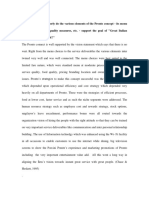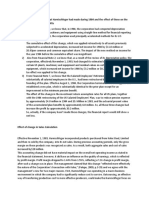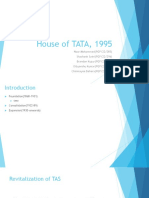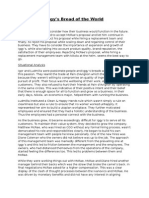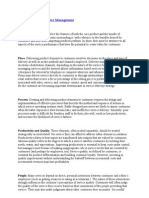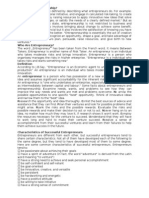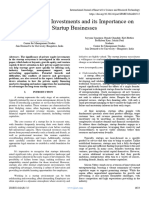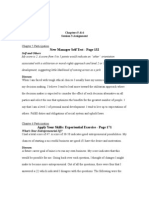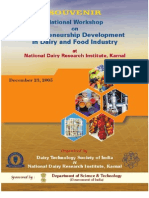Kapur - Sports in Your Pocket
Kapur - Sports in Your Pocket
Uploaded by
ak1147Copyright:
Available Formats
Kapur - Sports in Your Pocket
Kapur - Sports in Your Pocket
Uploaded by
ak1147Original Title
Copyright
Available Formats
Share this document
Did you find this document useful?
Is this content inappropriate?
Copyright:
Available Formats
Kapur - Sports in Your Pocket
Kapur - Sports in Your Pocket
Uploaded by
ak1147Copyright:
Available Formats
Amit Kapur Professor Steven Rogers Entrepreneurial Finance FIN 446 Sports In Your Pocket Assumptions 1) Quantities of Guides=
4000 2) Reference to Management Team and Board of Advisors in Executive Summary (Exhibit 3) is towards Crites and Sanabria 3) Trademark of the words In Your Pocket is available and is able to be trademarked. 4) Idea can be patented. 5) Both Crites and Sanabria added value to SIYP for the Marketing Case Competition.
Income Statement (per guide) Revenue= Research & Writings= Design & Layout= Production= Warehousing= COGS= Gross Profit= Distribution= Operating Profit= $6.95 $0.08 $0.20 $0.80 $0.02 $1.10 $5.86 $3.13 $2.73 %= 39.24% High Operating Margin %= 84.24% Very High Gross Margin
Case Questions 1) Which option should Dame pursue (Part Time Crites and Full Time Sanabria, Find a buyer for the concept, or Sell partially to Morrow & Daniel while retaining partnership share)? ANSWER: Dame should pursue the option of developing this business with Crites, who can contribute on a Part Time basis, and Sanabria who can contribute on a Full Time basis.
Amit Kapur Professor Steven Rogers Entrepreneurial Finance FIN 446 JUSTIFICATION: The Income Statement above (per guide) is impressive, specifically with a high Gross Margin potential and a high Operating Margin potential. Furthermore, this business is entirely scalable because sports are a craze, not only in the United States, but in all other countries as well (Cricket with Asia and Football in Europe). Its conceivable that Dame could make this work in all 4 major sports in about 30 cities in America, and then scale this idea to other countries. With the patent, Dame could license not only the idea worldwide, but can also license the words In Your Pocket to other producers of guides of other types as well. Dame has an entrepreneurial spirit in him, most supported by his creation and actualization of the idea FIYP, his ability to steer his team to victory in the Marketing Case Competition (which also shows camaraderie amongst the trio) and his decision to focus on Entrepreneurship at Kellogg. According to Exhibit 2, Crites and Sanabria seem to add value to the team. Crites has extensive advertising background with Nestle, which could be converted into monetary gain for SIYP, particularly if advertising is a revenue stream for the company. He also has the ability to analyze marketing expenditures and is very good at multi-tasking (since he was able to work at Pepsico and complete his degree at Kellogg simultaneously). He also has training capabilities from his days at Northern Trust. Among other things, Sanabria has a knack for leadership, supported by his GEM Engineering Fellowship Scholarship. The group already has an oral commitment for at least 100-500 guides for all major sports venue, which is a very lucrative contract for a startup, particularly because of the exposure it brings to the company. Replicating these contracts in the future should be easier, and at much greater magnitude. It is also conceivable that, as this idea generates momentum, Crites would consider leaving his job to continue to expand the company on a full time basis. He also had the ability to bring in his friend Pete Schoenke (extensive synergies with SIYP). Outsourcing most of the tasks would allow for a smoother operation initially, which would take the pressure off the time commitment of the three principles of the company. 2) If the deal was struck with Morrow & Daniel, what should be owed to Crites & Sanabria? Was the course credit and fair share of $10,000 prize compensation enough? ANSWER: Fair share of prize money and course credit compensation is not enough. If a deal is struck with Morrow & Daniel, Crites and Sanabria should each get 10% equity. JUSTIFICATION: Technically there is no agreement that makes Dame liable to share any of the proceeds earned from the sale of SIYP, however, that does not Crites and Sanabria do not deserve a share. Both of them had discussed adding $10,000 each to the business should Dame be willing to take on the idea of pursuing SIYP on a full time basis. Though capital had not yet been exchanged, they would have added approximately 31% capital to the business if Dame had given them the green light. Even though Dame had conceived the idea, Crites and Sanabria made it clear that they wanted to actualize this idea into an existing business, which shows intention, and if Dames is concerned about ethics, then he must consider that. Sanabria recalled that dividing equity was just not a priority for the team because the focus should remain on developing the marketing plan, given the time limitations. His faith in his
Amit Kapur Professor Steven Rogers Entrepreneurial Finance FIN 446 friendship with the other two allowed him to keep that conversation pending, and if Dame was considering compensating the two for the time invested, then that means he truly felt they were deserving of equity (otherwise he would have just considered their time commitment as part of the class course). That said, the two had not yet made a monetary investment, so everything they brought to the table thus far was mere sweat equity. I would normally value sweat equity at 5-10% but since they had the intention of investing, 10% each seems equitable both from a business and ethical standpoint. Dame deserved an 80% ownership since he had invested all of the capital ($12,000), conceptualized the idea of FIYP, developed the current business, and secured the copyright. 3) Would accepting another deal mean he was reneging on them? ANSWER: No. JUSTiFICATION: Reneging is when one fails to carry out an agreement, however the trio (Dame, Crites and Sanabria) have not yet come to an agreement. In fact Sanagria and Crites have given Dame the option of continuing on with his career path, just as they would continue on with theirs, should he decide not to pursue SIYP. They may be disappointed, but accepting another deal would not mean reneging, since no deal was currently in place.
Amit Kapur Professor Steven Rogers Entrepreneurial Finance FIN 446
You might also like
- Case Analysis1-Olymel-Strategic Expansion in The Pork IndustryDocument10 pagesCase Analysis1-Olymel-Strategic Expansion in The Pork IndustryHanna100% (1)
- Operation ManagementDocument8 pagesOperation ManagementBhaavyn SutariaNo ratings yet
- MAN 385.33 - Managing and Marketing in The Global Arena - Doggett - 04720Document14 pagesMAN 385.33 - Managing and Marketing in The Global Arena - Doggett - 04720Eneet Singh RanaNo ratings yet
- Frito Lay and The 4 P'sDocument8 pagesFrito Lay and The 4 P'sTracyNo ratings yet
- Entrepreneurship Development Case Study - 2 Balanced SnackingDocument4 pagesEntrepreneurship Development Case Study - 2 Balanced SnackingAvicennaNo ratings yet
- Webasto Case: Why Would Webasto Want To Create A New Innovation Process?Document2 pagesWebasto Case: Why Would Webasto Want To Create A New Innovation Process?RahulNo ratings yet
- Iggys Bread of The WorldDocument9 pagesIggys Bread of The WorldHaris AhmedNo ratings yet
- Price Elasticity KodakDocument2 pagesPrice Elasticity KodakSahil SafiNo ratings yet
- Ad Lider CaseDocument5 pagesAd Lider CaseSanchit DekateNo ratings yet
- Various Stages of Venture Capital FinancingDocument9 pagesVarious Stages of Venture Capital FinancingRyan FurtadoNo ratings yet
- Module 1 Introduction and Business Start-UpDocument25 pagesModule 1 Introduction and Business Start-UpLong Dong MidoNo ratings yet
- DressenDocument22 pagesDressenGonz�lez Alonzo Juan ManuelNo ratings yet
- Einventing Your Business ModelDocument17 pagesEinventing Your Business ModelSrishti Chadha100% (1)
- Welcome To The Capstone Rehearsal Tutorial!Document10 pagesWelcome To The Capstone Rehearsal Tutorial!Abhishek Singh ChauhanNo ratings yet
- Dell Case Analysis DraftDocument18 pagesDell Case Analysis DraftAnil TripathiNo ratings yet
- Cadbury Schweppes: Capturing Confectionary: Case AnalysisDocument2 pagesCadbury Schweppes: Capturing Confectionary: Case Analysishimanshu sagarNo ratings yet
- Jindi EnterprisesDocument2 pagesJindi EnterprisesVvb SatyanarayanaNo ratings yet
- Summary Chapter 8,9 Keat N YoungDocument7 pagesSummary Chapter 8,9 Keat N YoungIqbal Faisal AkhmadNo ratings yet
- CaseDocument23 pagesCaseNguyễnVũHoàngTấnNo ratings yet
- BenDocument5 pagesBenSaad JavedNo ratings yet
- 1800flowers Com Company AnalysisDocument21 pages1800flowers Com Company AnalysissyedsubzposhNo ratings yet
- American Well - Case StudyDocument2 pagesAmerican Well - Case StudyVeenus YadavNo ratings yet
- Base CampDocument1 pageBase CampPranav TyagiNo ratings yet
- TruEarth Healthy FoodsDocument1 pageTruEarth Healthy FoodsAbhinav SinghNo ratings yet
- How Serious Were Stephen Richards' Actions? Why?Document4 pagesHow Serious Were Stephen Richards' Actions? Why?Dave LauNo ratings yet
- Kmart and SearsDocument19 pagesKmart and Searsshibanibordia100% (1)
- Zebra PresentationDocument6 pagesZebra PresentationShaloo MinzNo ratings yet
- Group 12 Ikea CaseDocument4 pagesGroup 12 Ikea CaseMichaelKiprono100% (1)
- Case Study1Document8 pagesCase Study1Shahinsha100% (1)
- ASSIGNMENT - Health City Cayman Islands - Ritika SharmaDocument2 pagesASSIGNMENT - Health City Cayman Islands - Ritika SharmaRitika SharmaNo ratings yet
- Boo.com.pptDocument11 pagesBoo.com.pptMary Jean Asuncion BrocoyNo ratings yet
- Deutsche AllgemeinversicherungDocument4 pagesDeutsche AllgemeinversicherungThinakaran S BNo ratings yet
- Group 5 Honey Care - Case SummaryDocument4 pagesGroup 5 Honey Care - Case SummaryAndi MarjokoNo ratings yet
- Computer AssociatesDocument18 pagesComputer AssociatesRosel RicafortNo ratings yet
- Stamypor CaseDocument15 pagesStamypor CaserockysanjitNo ratings yet
- Krispy Kreme Doughnuts-Suggested QuestionsDocument1 pageKrispy Kreme Doughnuts-Suggested QuestionsMohammed AlmusaiNo ratings yet
- The Brita Products Company Case ReportDocument3 pagesThe Brita Products Company Case ReportSojung Yoon100% (1)
- Davey MukullDocument6 pagesDavey MukullMukul Kumar SinghNo ratings yet
- Will Balbir Pasha Get AIDS FULL Case Study PDFDocument11 pagesWill Balbir Pasha Get AIDS FULL Case Study PDFSALONI GUPTANo ratings yet
- Introduction of ZaraDocument5 pagesIntroduction of ZaraFahmeeda AtherNo ratings yet
- Comparison of Dell and Zara Supply ChainDocument3 pagesComparison of Dell and Zara Supply ChainPart Khatsig AlexanNo ratings yet
- A New Shirt-StrategicDocument7 pagesA New Shirt-StrategicKamal AhmmadNo ratings yet
- Case - Shaina - SudiptaDocument3 pagesCase - Shaina - SudiptaCeril Antony0% (1)
- Case 3 OBDocument3 pagesCase 3 OBAlvaro Sierra100% (1)
- Innocent Drinks Summary Evaluation of Strategic OptionsDocument2 pagesInnocent Drinks Summary Evaluation of Strategic Optionsapi-264830195No ratings yet
- Case StudyDocument4 pagesCase StudyArifNo ratings yet
- Truearth Healthy Foods: Market Research For A New Product IntroductionDocument5 pagesTruearth Healthy Foods: Market Research For A New Product IntroductionFree Guy100% (1)
- Strategic ManagentDocument2 pagesStrategic Managentmurtaza259100% (1)
- Section B Group 7 CyworldDocument12 pagesSection B Group 7 CyworldlaxmanNo ratings yet
- PDFDocument5 pagesPDFAzeem MajeedNo ratings yet
- Case Two - GE Healthcare in IndiaDocument3 pagesCase Two - GE Healthcare in IndiaAaina Jaiswal100% (1)
- Developing Appropriate Leadership StylesDocument20 pagesDeveloping Appropriate Leadership StylesRichmond MsowoyaNo ratings yet
- Scharles Schwab Case - Group 5 - Section ADocument8 pagesScharles Schwab Case - Group 5 - Section ABunny SethiNo ratings yet
- SWOT AnaysisDocument3 pagesSWOT AnaysishodaNo ratings yet
- Lululemon Submission To Parliamentary Finance CommitteeDocument7 pagesLululemon Submission To Parliamentary Finance CommitteedanieltencerNo ratings yet
- Sonyeyetoyfinalreport 120701110922 Phpapp02Document14 pagesSonyeyetoyfinalreport 120701110922 Phpapp02Saksham SinhaNo ratings yet
- Accounting Policy Changes That Harnischfeger Had Made During 1984 and The Effect ofDocument4 pagesAccounting Policy Changes That Harnischfeger Had Made During 1984 and The Effect ofAdityaSinghNo ratings yet
- EOS House of TATA RevitalizationDocument4 pagesEOS House of TATA Revitalizationchinmayee beheraNo ratings yet
- 5 PorterDocument10 pages5 PorterkulsoomalamNo ratings yet
- Iggy's Bread of The World - Written Analysis and CommunicationDocument3 pagesIggy's Bread of The World - Written Analysis and CommunicationAshmitaSengupta50% (2)
- F402 - Corporate Strategy and Governance Case Assignment - Due September 22, 2020 at 9:25AM "Victoria Chemicals PLC (A) : The Merseyside Project"Document1 pageF402 - Corporate Strategy and Governance Case Assignment - Due September 22, 2020 at 9:25AM "Victoria Chemicals PLC (A) : The Merseyside Project"Harrison GalavanNo ratings yet
- Principles of Management or VBMDocument56 pagesPrinciples of Management or VBMAftaab AhmedNo ratings yet
- Capt GopinathDocument5 pagesCapt GopinathhariselvarajNo ratings yet
- CONTINUING EDUCATION - BrochureDocument36 pagesCONTINUING EDUCATION - BrochureNguyen Binh SonNo ratings yet
- Banchetto RubricsDocument7 pagesBanchetto RubricsDaniel LucasNo ratings yet
- Unit 3 EdDocument14 pagesUnit 3 Edtilak kumar vadapalliNo ratings yet
- Introduction To Entrepreneurship: Bruce R. Barringer R. Duane IrelandDocument27 pagesIntroduction To Entrepreneurship: Bruce R. Barringer R. Duane IrelandAbu Bakar YousafNo ratings yet
- Instant Download Ebook PDF Business Analysis Valuation Using Financial Statements 2 PDF ScribdDocument28 pagesInstant Download Ebook PDF Business Analysis Valuation Using Financial Statements 2 PDF Scribdlillie.mitchell825100% (48)
- NSTP 1Document7 pagesNSTP 1Nikko GorneNo ratings yet
- SF 9 - SHS - Sy 2022 2023Document14 pagesSF 9 - SHS - Sy 2022 2023Mark Jhosua Austria Galinato100% (1)
- SWOT Analysis of SHG in Odisha PDFDocument7 pagesSWOT Analysis of SHG in Odisha PDFpurnendupatraNo ratings yet
- Laundromax CASEDocument7 pagesLaundromax CASEMonisha MalhotraNo ratings yet
- How To Divide Founder Equity - 4 Criteria To DiscussDocument2 pagesHow To Divide Founder Equity - 4 Criteria To DiscussMihir PershadNo ratings yet
- Entrepreneurship NOTESDocument34 pagesEntrepreneurship NOTESIndronil Mukherjee100% (1)
- Exploring Business Version 3 0 3rd Collins Test BankDocument26 pagesExploring Business Version 3 0 3rd Collins Test BankTravis Bogan100% (41)
- NSS Exploring Economics 2 (3rd Edition) Answers To Exercises Chapter 10 Factors of ProductionDocument17 pagesNSS Exploring Economics 2 (3rd Edition) Answers To Exercises Chapter 10 Factors of ProductiondizzelNo ratings yet
- Hamza - EntreDocument15 pagesHamza - EntreAnas InamNo ratings yet
- CV - Ahmed OsmanDocument2 pagesCV - Ahmed OsmanAhmed SamerNo ratings yet
- Kingston University Masters DissertationDocument5 pagesKingston University Masters DissertationWriteMyEnglishPaperForMeSingapore100% (1)
- Private Equity Investments and Its Importance On Startup BusinessesDocument6 pagesPrivate Equity Investments and Its Importance On Startup BusinessesInternational Journal of Innovative Science and Research TechnologyNo ratings yet
- THE JOPADHOLA COMMUNITY - 30TH AUG - 2.17 ProfessorDocument5 pagesTHE JOPADHOLA COMMUNITY - 30TH AUG - 2.17 ProfessorjadwongscribdNo ratings yet
- Women EntrepreneurDocument16 pagesWomen EntrepreneurTulika KumarNo ratings yet
- Tagum City College of Science and Technology Foundation IncDocument2 pagesTagum City College of Science and Technology Foundation IncClaire MabalotNo ratings yet
- Stanford ViewbookDocument54 pagesStanford Viewbookchinmay67% (3)
- Microfinance and Women EntrepreneurshipDocument8 pagesMicrofinance and Women EntrepreneurshipMEERA RAVI PSGRKCWNo ratings yet
- Chapter1 EntrepreneurshipDocument2 pagesChapter1 EntrepreneurshipSVPSNo ratings yet
- New Manager Self Test - Page 132: Chapters 5 & 6 Session 3 AssignmentDocument9 pagesNew Manager Self Test - Page 132: Chapters 5 & 6 Session 3 AssignmentJessica FrickNo ratings yet
- Entrepreneurship Development in Dairy and Food IndustryDocument135 pagesEntrepreneurship Development in Dairy and Food IndustryMayank Tandon92% (24)
- Script Emcees Webinar EntrepDocument3 pagesScript Emcees Webinar EntrepAngelokeizer Gavino100% (1)

















































